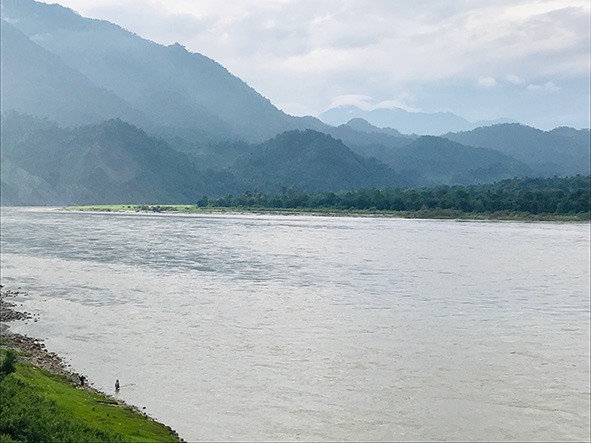
[ Tongam Rina ]
ITANAGAR, Nov 30: China is planning to build a hydropower project on the Yarlung Zangbo (Tsangpo) river downstream, according to the Communist Party-run Global Times newspaper.
Yarlung Tsanpo is Siang in Arunachal.
Quoting the chairman of the Power Construction Corp of China, or POWERCHINA, which is the Chinese government agency for hydropower, it reported that China will implement hydropower exploitation in the downstream of the Yarlung Zangbo river in Tibet and this was clearly put forward in the proposals for formulating the country’s 14th Five-Year Plan (2021-25) and its long-term goals through 2035 made by the Central Committee of the Communist Party of China.
POWERCHINA chairman Yan Zhiyong is reported to have made the comment on Thursday to mark the 40th anniversary of the founding of the China Society for Hydropower Engineering.
Sixty million kWh hydropower exploitation at the downstream of the Yarlung Zangbo river could provide 300 billion kWh of clean, renewable and zero-carbon electricity annually, the paper reported, quoting Zhiyong.
“It is a project for national security, including water resources and domestic security,” the POWERCHINA chairman said, noting that the project will also smooth cooperation with South Asia, the Global Times reported.
POWERCHINA on 16 October signed a strategic cooperation agreement covering the 14th Five-Year Plan with the Tibet Autonomous Region, it said.
Though no details were given, the report stated that “speculations about China planning to build a “super hydropower station” in Medog county, where the Yarlung Zangbo Grand Canyon is located, have circulated for years.”
Meanwhile, the report of the proposed project in the downstream of the Yarlung Zangbo has been received with apprehension in
Arunachal and elsewhere.
Congress MLA Ninong Ering said that the state government should seek clarity from the Centre as the whole ecology in the downstream would be destroyed.
“It is really going to disturb the downstream ecology and I don’t want Assam and Arunachal to become deserts,” he said.
He further said that China has the upper hand, as India has not been able to utilize the water in Arunachal.
Neeraj Vagholikar of the environment research and advocacy group Kalpavriksh said “News about a proposed mega dam on the Yarlung Zangbo river close to the line of actual control (LAC) in Tibet, is a matter of very serious concern. Although specific details are awaited, this could potentially cause serious downstream impacts on the Siang in Arunachal Pradesh and the Brahmaputra floodplains in Assam.”
“Downstream impacts of dams on the Brahmaputra floodplains in Assam has been a major issue of debate over the past decade in the region, including projects being built or proposed in China and those within Indian territory,” he said.
Such a mega dam could potentially put at risk downstream populations, floodplain livelihoods and ecologically sensitive riverine ecosystems such as the Daying Ering sanctuary in Arunachal and the Dibru Saikhowa National Park in Assam. Also, it will likely have an impact on the Kaziranga National Park further downstream.
“The government of India should immediately seek detailed information and raise concerns about this planned development,” Vagholikar said.
Activist Jarjum Gamlin Ete said that the rights of the lower riparian countries should be respected, and she urged the Centre to work on a water sharing treaty with China and Bangladesh.
The Forum for Siang Dialogue said that the government of India must take up the matter with China and express its strong opposition to the HEP in the upstream of the Siang.
“China will not lose anything but Arunachal will be the first to face the impact,” said its spokesperson Vijay Taram.
“Without any agreement on water sharing, China should not build HEPs as there are going to be direct repercussion on downstream (Arunachal),” he said.
The world community has to think on China’s latest plan as environment is set to suffer, Taram said, adding that all countries must be compassionate towards the environment.
Researcher Chintan Sheth said that it is a region with high concentration of glaciers and glacial lakes, coupled with peculiar seismicity and high biodiversity.
“Any kind of large infrastructure here will be a violation of the pledge to adopt the Sendai Framework for Disaster Risk Reduction signed by China. It will also be a violation of their pledge to conserve biodiversity as part of the recent UN summit biodiversity summit,” he said.
The report of China’s plan, though not directly from the Chinese government but through one of its agencies, will be watched keenly, even though there is no response as yet from the Indian government and the state government. The state government refused to respond to the latest report.
Though researchers differ in their views, natural upstream activities, including earthquakes in Tibet, are reported to have caused changes in the flow of water as well as increased sediment load and blackened the Siang in the winter of 2017.
There is an agreement between India and China on sharing information on the flow of water, which is patchy at most; there is no water sharing treaty with China, which gives the upper hand to the upstream country.


